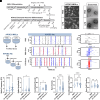Microglia-to-neuron signaling links APOE4 and inflammation to enhanced neuronal lipid metabolism and network activity
- PMID: 40920927
- PMCID: PMC12452947
- DOI: 10.1073/pnas.2516103122
Microglia-to-neuron signaling links APOE4 and inflammation to enhanced neuronal lipid metabolism and network activity
Abstract
Microglia regulate neuronal circuit plasticity. Disrupting their homeostatic function has detrimental effects on neuronal circuit health. Neuroinflammation contributes to the onset and progression of neurodegenerative diseases, including Alzheimer's disease (AD), with several microglial activation genes linked to increased risk for these conditions. Inflammatory microglia alter neuronal excitability, inducing metabolic strain. Interestingly, expression of APOE4, the strongest genetic risk factor for AD, affects both microglial activation and neuronal excitability, highlighting the interplay between lipid metabolism, inflammation, and neuronal function. It remains unclear how microglial inflammatory state is conveyed to neurons to affect circuit function and whether APOE4 expression alters this intercellular communication. Here, we use a reductionist model of human iPSC-derived microglial and neuronal monocultures to dissect how the APOE genotype in each cell type independently contributes to microglial regulation of neuronal activity during inflammation. Conditioned media (CM) from LPS-stimulated microglia increased neuronal network activity, assessed by calcium imaging, with APOE4 microglial CM driving greater neuronal activity than APOE3 CM. Both APOE3 and APOE4 neurons increase network activity in response to CM treatments, while APOE4 neurons uniquely increase presynaptic puncta in response to APOE4 microglial CM. CM-derived exosomes from LPS-stimulated microglia can mediate increases to network activity. Finally, increased network activity is accompanied by increased lipid droplet (LD) metabolism, and blocking LD metabolism abolishes network activity. These findings illuminate how microglia-to-neuron communication drives inflammation-induced changes in neuronal circuit function, demonstrate a role for neuronal LDs in network activity, and support a potential mechanism through which APOE4 increases neuronal excitability.
Keywords: APOE4; Alzheimer’s disease; exosomes; lipid droplets; microglia.
Conflict of interest statement
Competing interests statement:The authors declare no competing interest.
Figures




Update of
-
Microglia-to-neuron signaling increases lipid droplet metabolism, enhancing neuronal network activity.bioRxiv [Preprint]. 2025 Aug 3:2025.08.03.668224. doi: 10.1101/2025.08.03.668224. bioRxiv. 2025. Update in: Proc Natl Acad Sci U S A. 2025 Sep 16;122(37):e2516103122. doi: 10.1073/pnas.2516103122. PMID: 40766379 Free PMC article. Updated. Preprint.
References
-
- Marinelli S., Basilico B., Marrone M. C., Ragozzino D., Microglia-neuron crosstalk: Signaling mechanism and control of synaptic transmission. Semin. Cell Dev. Biol. 94, 138–151 (2019). - PubMed
MeSH terms
Substances
Grants and funding
LinkOut - more resources
Full Text Sources
Research Materials
Miscellaneous

